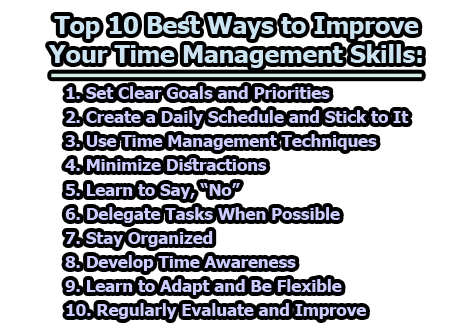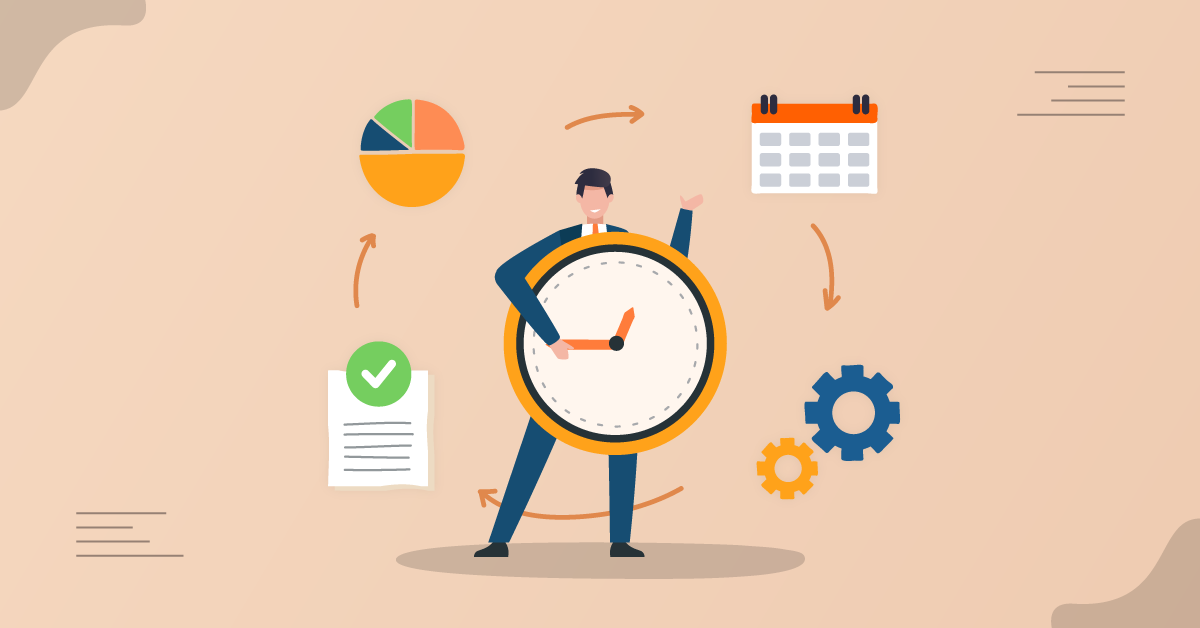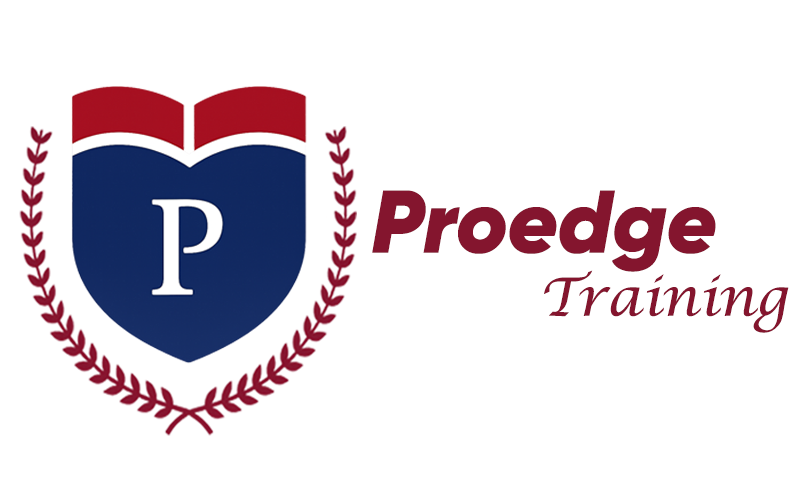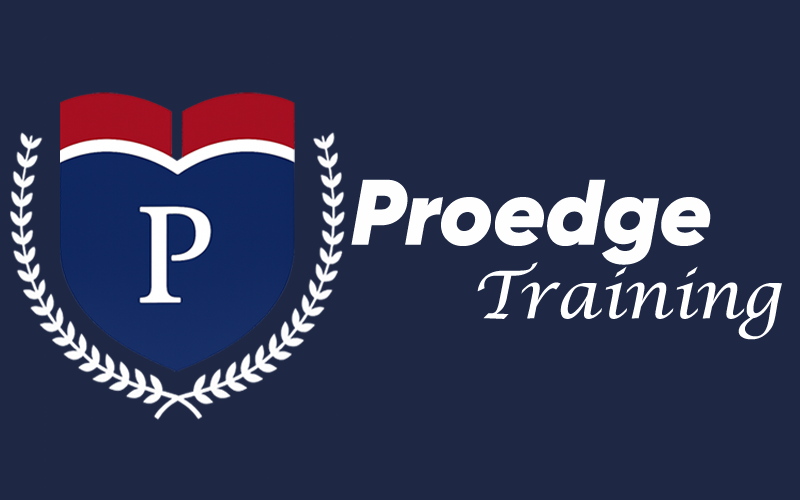
10 Steps to Improving Your Time Management Skills: Master Efficiency
Time management is crucial for productivity and stress reduction. Everyone can benefit from better managing their time.
In our fast-paced world, juggling tasks can be overwhelming. Deadlines loom, and distractions abound. Mastering time management is essential for achieving goals and maintaining balance. It’s not just about doing more in less time. It’s about doing the right things at the right time.
Effective time management helps you prioritize, plan, and execute tasks efficiently. It allows you to focus on what truly matters. By refining these skills, you can enhance your personal and professional life. In this blog post, discover ten practical steps to boost your time management abilities. These strategies can help you reclaim control, reduce stress, and improve productivity. Let’s explore how to make time work for you.
Assess Your Current Skills
Improving your time management skills starts with a clear understanding of your current abilities. Assessing your skills helps you identify areas that need improvement and those that are already strong. This foundational step is crucial for developing effective scheduling, enhancing self-discipline, and discovering procrastination solutions. By evaluating your skills, you can tailor productivity tips and time management techniques to suit your unique needs. Knowing where you stand allows you to set realistic goals, refine task delegation, and achieve a better work-life balance.
Identify Weaknesses
Identifying weaknesses in your time management skills can be a game-changer. It helps you pinpoint specific areas where you struggle, such as procrastination or poor prioritization methods. Once you recognize these weaknesses, you can take steps to address them. Consider these common weaknesses:
- Poor prioritization methods
- Lack of effective scheduling
- Difficulty with task delegation
- Inadequate goal setting strategies
- Weak self-discipline improvement
For a clearer picture, create a table listing your tasks:
| Task | Difficulty | Time Spent |
|---|---|---|
| Email Management | High | 3 hours/day |
| Meeting Preparation | Medium | 2 hours/day |
| Project Work | Low | 1 hour/day |
Identify tasks that consume too much time or cause stress. Use time tracking tools to gain insights. Adjust your approach and explore productivity tips to improve efficiency.
Evaluate Strengths
Evaluating strengths in time management is just as important as identifying weaknesses. Recognizing your strengths can boost your confidence and help you build on them for greater efficiency. Consider these strengths:
- Strong goal setting strategies
- Effective scheduling habits
- Good task delegation
- Excellent self-discipline improvement
- Ability to maintain work-life balance
Rate your strengths:
| Skill | Rating (1-5) |
|---|---|
| Prioritization Methods | 4 |
| Time Management Techniques | 5 |
| Productivity Tips | 3 |
Focus on leveraging these strengths. For example, if you excel in goal setting, use this skill to plan long-term projects. If you have good self-discipline, apply it to reduce distractions. By building on your strengths, you enhance your overall time management capabilities.
Set Clear Goals
Effective time management is essential for success in today’s fast-paced world. One of the most crucial aspects of mastering time management is setting clear goals. Clear goals act as a roadmap, guiding you toward your desired outcomes. They help you focus, minimize distractions, and allocate your time wisely. Without clear goals, it’s easy to drift aimlessly, wasting precious hours. By defining what you want to achieve, both in the short term and long term, you can implement various time management techniques and productivity tips to enhance personal efficiency and achieve a better work-life balance.
Short-term Objectives
Short-term objectives are immediate goals you aim to achieve within a day, week, or month. These objectives are stepping stones toward your larger aspirations. They require effective scheduling and prioritization methods to ensure they are completed on time. Here are ways to set and accomplish short-term objectives:
- Prioritization Methods: Identify tasks that are urgent and important. Use tools like the Eisenhower Box to decide what needs immediate attention.
- Time Blocking: Allocate specific time slots for each task. This helps in maintaining focus and reducing the urge to procrastinate.
- Task Delegation: Share responsibilities where possible. Delegating can free up time for tasks that require your unique skills.
- Procrastination Solutions: Recognize procrastination triggers and develop strategies to overcome them, such as the Pomodoro Technique.
Consider using a table to organize your short-term goals:
| Objective | Deadline | Priority |
|---|---|---|
| Complete project report | End of the week | High |
| Respond to emails | Daily | Medium |
| Attend team meeting | Tomorrow | High |
Long-term Aspirations
Long-term aspirations are goals set for the future, often spanning several months or years. These goals require more elaborate planning and consistent effort. Here’s how you can effectively set and achieve long-term aspirations:
- Goal Setting Strategies: Break down large goals into smaller, manageable tasks. This makes them less overwhelming and easier to track.
- Effective Scheduling: Develop a timeline for your aspirations. Schedule regular check-ins to assess progress and make adjustments if necessary.
- Personal Efficiency: Focus on improving skills that contribute to achieving long-term goals. This might include learning new technologies or enhancing communication abilities.
- Work-Life Balance: Ensure your long-term goals align with personal values and life ambitions. Balance work commitments with personal growth and leisure.
Use a structured approach to monitor your progress:
| Goal | Estimated Completion | Progress |
|---|---|---|
| Earn a degree | 2 years | Started |
| Launch a business | 3 years | Planning phase |
| Travel extensively | 5 years | Researching destinations |
By consistently working towards your long-term aspirations, you can employ various time management techniques to ensure steady progress, ultimately achieving your desired outcomes.
Prioritize Tasks
Managing your time well can change your day-to-day life. One of the most effective time management techniques is to prioritize tasks. It helps you focus on what truly matters. With prioritization methods, you can organize your tasks by urgency and importance. This approach supports effective scheduling and leads to better productivity. Let’s explore how you can use prioritization techniques to enhance your work-life balance.
Use The Eisenhower Matrix
The Eisenhower Matrix is a powerful tool for task organization. It divides tasks into four categories based on urgency and importance. This method helps you decide what to work on first.
- Urgent and Important: These tasks need immediate attention. They impact your deadlines or goals. Handle them right away to avoid stress.
- Important but Not Urgent: Schedule these tasks. They help in reaching long-term goals. Use time blocking to fit them into your calendar.
- Urgent but Not Important: Delegate these tasks if possible. They can distract you from important work.
- Neither Urgent nor Important: These tasks can be set aside. They do not contribute much to productivity.
Implementing the Eisenhower Matrix can lead to efficiency improvement. It encourages thoughtful decision-making and helps maintain a healthy work-life balance. This task organization method keeps you focused and reduces time wastage.
Rank By Importance
Ranking tasks by importance is another effective prioritization method. It allows you to focus on tasks that align with your goals. This approach supports goal-setting strategies and enhances productivity.
- Identify Your Goals: Know what you want to achieve. Clear goals guide your task priorities.
- List Your Tasks: Write down all tasks. It helps you see what needs attention.
- Rate Each Task: Assign a value based on its impact on your goals. Consider both short-term and long-term effects.
- Order Tasks: Arrange tasks from most to least important. This order helps in effective scheduling.
Ranking by importance ensures that your time is spent on tasks that matter. This method enhances your productivity and promotes better efficiency. It also supports work-life balance by preventing burnout. By focusing on important tasks, you achieve more in less time.
Create A Schedule
Creating a schedule is a fundamental step in improving your time management skills. This approach helps in organizing tasks efficiently and prioritizing what needs to be done. A well-structured schedule can enhance productivity and personal efficiency by reducing procrastination. Whether you are aiming for better work-life balance or trying to implement effective scheduling techniques, crafting a daily and weekly plan is essential. This section will guide you through daily planning and weekly overview strategies to boost your productivity and time management.
Daily Planning
Daily planning involves setting aside time each day to organize tasks and activities. It helps in focusing on immediate priorities and ensures that every day is productive. Begin by listing tasks that need attention. For effective scheduling, use time blocking. Allocate specific time slots for each task. This method aids in minimizing distractions and enhancing concentration.
- Task Delegation: Identify tasks that can be delegated. Sharing work lightens the load.
- Goal Setting: Define daily goals. Clear objectives help in measuring success.
- Procrastination Solutions: Tackle the most challenging tasks first. Avoid delaying important work.
Consider using a table to plan your day:
| Time | Task | Priority |
|---|---|---|
| 8:00 AM – 9:00 AM | Emails | High |
| 9:00 AM – 11:00 AM | Project Work | Medium |
| 11:00 AM – 12:00 PM | Meeting | High |
By following a structured daily plan, you can improve personal efficiency and manage time effectively.
Weekly Overview
A weekly overview provides a broader perspective on tasks and goals. It allows for better prioritization strategies and helps in maintaining a balanced workload. Start by reviewing the previous week. Identify areas for improvement. Set goals for the upcoming week. This technique aids in long-term productivity.
- Review Completed Tasks: Assess what was accomplished. Note successes and failures.
- Plan Ahead: Determine tasks for the week. Include both work and personal commitments.
- Effective Scheduling: Use a calendar. Block time for significant activities.
Incorporate a table to outline your weekly plan:
| Day | Major Tasks | Notes |
|---|---|---|
| Monday | Team Meeting | Prepare agenda |
| Wednesday | Report Submission | Complete draft |
| Friday | Project Review | Gather feedback |
Weekly planning encourages a focus on work-life balance. It aligns tasks with both professional and personal goals.
Utilize Tools
Improving your time management skills can be a daunting task. But with the right tools, it becomes much easier. Tools can help you stay organized and focused. They can assist in managing your tasks and schedules effectively. Whether you prefer digital apps or traditional planners, each has its own benefits. These tools can aid in improving self-discipline methods and prioritization methods. They can also enhance productivity tips and time management techniques. Let’s explore how utilizing these tools can help you better manage your time.
Digital Apps
Digital apps are powerful tools for time management. They offer various features that can help you stay organized. Here are some benefits of using digital apps:
- Task Organization: Apps like Trello and Asana allow you to organize tasks with ease.
- Effective Scheduling: Google Calendar helps you schedule and set reminders.
- Goal Setting Strategies: Apps like Todoist allow you to set goals and track progress.
These apps often have features like:
| Feature | Description |
|---|---|
| Time Blocking | Allocate specific times for tasks. |
| Work-Life Balance | Set boundaries for work and personal time. |
| Notifications | Receive alerts for upcoming tasks. |
Digital tools for time management can be accessed anywhere, making them versatile. They can help improve self-discipline and ensure that you meet deadlines. Utilizing these tools can be a game-changer for enhancing productivity and managing your time more efficiently.
Traditional Planners
Traditional planners are a classic choice for many. They offer a tactile experience that digital apps cannot. Here are some benefits of using traditional planners:
- Tangible Planning: Writing down tasks can improve memory retention.
- Customization: You can personalize your planner to suit your needs.
- Focus: Less digital distraction means better focus.
Traditional planners can be used for:
- Creating self-discipline methods by setting daily routines.
- Implementing prioritization methods by listing tasks in order of importance.
- Building time management techniques by allocating specific time slots for activities.
Planners are excellent for people who enjoy the act of writing. The process of physically writing can aid in mental planning. It allows for a moment of reflection and planning, free from the distractions of digital screens. Traditional planners can be a valuable tool for anyone looking to improve their time management.

Limit Distractions
Improving your time management skills can transform your daily routine, leading to increased productivity and reduced stress. One crucial step in this journey is learning to limit distractions. Distractions can derail your focus, slow down progress, and make efficient task delegation difficult. By minimizing interruptions, you pave the way for better productivity improvement and efficiency strategies. Let’s explore how to identify what triggers distractions and implement techniques to maintain focus.
Identify Triggers
Understanding what causes distractions is essential for effective time management. Identifying triggers can help you tailor your environment to minimize interruptions. Common triggers include:
- Notifications: Constant alerts from devices can disrupt concentration.
- Environmental Factors: Noise or visual clutter in your workspace.
- Social Media: The allure of social platforms often leads to procrastination.
Consider creating a table to track triggers:
| Trigger | Impact on Productivity | Solution |
|---|---|---|
| Phone Notifications | High | Turn off alerts during work hours |
| Background Noise | Medium | Use noise-cancelling headphones |
| Social Media | High | Limit usage with app blockers |
Tracking these triggers can aid in prioritization techniques and goal setting, ensuring that distractions do not hinder your work.
Implement Focus Techniques
Once triggers are identified, applying focus enhancement methods can further support your time management efforts. Here are some effective techniques:
- Time Blocking: Allocate specific time slots for tasks, ensuring dedicated focus periods.
- Mindfulness Practices: Regular meditation can sharpen attention and reduce stress.
- Procrastination Solutions: Break tasks into smaller, manageable parts to tackle them efficiently.
Efficiency strategies like these can significantly improve concentration and productivity. Consider using apps designed for task delegation and focus enhancement. These tools can keep you accountable, ensuring that your time blocking and prioritization techniques are well-executed. Remember, the key is to create an environment conducive to focus, supporting your productivity improvement journey.
Set Time Limits
Setting time limits can greatly enhance your time management skills. Allocating specific time frames to tasks helps maintain focus and ensures efficient use of each minute. This approach prevents procrastination and enables you to achieve your goals with ease. Implementing strategies like the Pomodoro Technique and Task Time Blocks can provide structure and clarity, fostering a productive environment. Discover how these techniques can streamline your day and optimize your workflow.
Pomodoro Technique
The Pomodoro Technique is a popular Productivity Technique that boosts focus and efficiency. It involves breaking work into intervals, typically 25 minutes, separated by short breaks. This method encourages consistent progress and helps manage distractions. Here’s how you can apply this Time Management Strategy:
- Set a timer: Choose a task and set a timer for 25 minutes.
- Work intensely: Focus solely on the task during this period.
- Take a break: Rest for 5 minutes after the timer rings.
- Repeat: After four cycles, take a longer break, around 15-30 minutes.
The Pomodoro Technique enhances concentration and minimizes burnout. Regular breaks improve mental agility and maintain high productivity levels. This Focus Technique is ideal for tasks requiring sustained attention and is an effective solution for combating procrastination. By dividing work into manageable chunks, you promote a balanced approach to task completion and improve work-life balance.
Task Time Blocks
Task Time Blocks are another effective Time Blocking method. This strategy involves allocating specific time slots to different tasks throughout the day. You can tailor these blocks to fit your priorities and workload. Consider the following steps to apply this Efficiency Improvement technique:
- Identify tasks: List tasks based on urgency and importance.
- Assign time blocks: Allocate specific time slots for each task.
- Stick to the schedule: Focus on the task within its assigned block.
- Review and adjust: Reflect on the effectiveness and make necessary adjustments.
Task Time Blocks encourage Effective Scheduling and Prioritization Methods. This structured approach reduces decision fatigue and enhances productivity. By dedicating time specifically to each task, you ensure that all responsibilities receive adequate attention. This method supports Goal Setting, as it offers a clear plan to achieve your objectives. Balancing tasks with dedicated time slots can improve both personal efficiency and work-life balance, making it a valuable strategy for any professional.

Review Progress
Improving your time management skills involves a series of steps that can help you make the most of your day. One of the crucial steps is to regularly review your progress. This process allows you to see where you’re excelling and where you need improvement. By doing so, you can make informed decisions about your next steps. Reviewing progress isn’t just about seeing what you’ve done; it’s also about understanding how you can do better. It involves reflecting on your prioritization methods and task delegation, ensuring you’re on the right path.
Weekly Assessments
Conducting weekly assessments is essential for tracking your time management progress. These assessments help you understand your strengths and weaknesses in managing time. By reviewing your weekly activities, you can identify patterns that work and those that don’t.
- Evaluate your goals: Check if you met your weekly goals. If not, understand why.
- Analyze your schedule: See if your effective scheduling is realistic and achievable.
- Reflect on productivity: Use productivity tips to boost your efficiency.
Below is a simple table to help with your weekly assessment: Add more rows as needed
| Day | Tasks Completed | Time Spent | Notes |
|---|---|---|---|
| Monday | 5 | 6 hours | Good start |
| Tuesday | 4 | 5 hours | Need to improve focus |
Remember, consistent performance evaluation helps in maintaining self-discipline.
Adjusting Strategies
After assessing your progress, the next step is adjusting strategies. This involves making changes to improve your time management techniques. You may find that some of your methods need tweaking to better suit your needs. Here are some strategies to consider:
- Time Blocking: Allocate specific time slots for tasks to increase focus.
- Task Delegation: Share responsibilities to manage workload better.
- Goal Setting Strategies: Set clear, achievable goals for better direction.
Adjustments should aim for a better work-life balance. This ensures you’re not overburdened and can maintain a healthy lifestyle. Regularly updating your time management techniques keeps you adaptable and efficient. It also helps in improving self-discipline and achieving long-term success.
Develop Healthy Habits
Improving your time management skills requires more than just organizing tasks. Developing healthy habits plays a crucial role in maximizing productivity and achieving a balanced life. By nurturing consistent routines and incorporating mindfulness practices, you can enhance focus, reduce stress, and streamline daily planning. These habits are not just about managing time; they’re about making time work for you.
Consistent Routines
Consistent routines are the backbone of effective scheduling and time management techniques. Establishing a regular schedule helps prioritize tasks and enhances focus. This can be achieved through goal setting and time-blocking methods.
- Daily Planning: Start each day by outlining key tasks. This reduces uncertainty and helps in prioritization strategies.
- Time-Blocking Methods: Allocate specific time slots for activities. This boosts productivity and ensures tasks are completed efficiently.
A simple table can be useful:
| Time | Activity |
|---|---|
| 8 AM – 9 AM | Exercise |
| 9 AM – 10 AM | Work |
| 10 AM – 11 AM | Emails |
By adopting consistent routines, you improve your work-life balance. This leads to better focus enhancement and a structured approach to managing daily tasks.
Mindfulness Practices
Mindfulness practices are vital for stress reduction techniques and improving focus. They allow you to be present and aware, which aids in effective scheduling. Consider these productivity tips:
- Meditation: Set aside time each day to meditate. It clears the mind and enhances concentration.
- Breathing Exercises: Use simple breathing techniques to calm the mind. This aids in stress reduction and boosts focus.
Mindfulness also supports prioritization strategies. It helps in making decisions based on clarity rather than urgency. These practices lead to a balanced approach in time management techniques. Incorporating mindfulness into daily routines enriches work-life balance. It fosters a calm environment where tasks are approached with intention and purpose.
Seek Feedback
Improving your time management skills can transform your daily routine. One crucial step is to seek feedback. Feedback offers fresh insights into your habits and practices. It helps identify areas for improvement and shines a light on overlooked strengths. Feedback is vital for enhancing skills like prioritization methods and organizational skills. It also aids in refining task delegation and discovering new productivity tips. You open yourself to growth and efficiency by inviting others to share their perspectives.
Peer Reviews
Engaging in peer reviews can enhance your time management techniques. Colleagues often notice things you might miss. They provide feedback on your effective scheduling and goal setting strategies. Here’s how peer reviews can help:
- Identify Strengths and Weaknesses: Peers can point out what you do well and what needs work.
- Offer New Perspectives: Different viewpoints can lead to innovative approaches.
- Encourage Accountability: Knowing that someone will review your process can boost your self-discipline.
In a structured peer review process, you might find it helpful to use a table like the one below to organize feedback:
| Area | Feedback | Action Plan |
|---|---|---|
| Task Delegation | Needs improvement in distributing tasks evenly. | Research effective delegation techniques. |
| Time-Blocking | Effective but needs consistency. | Set regular time slots daily. |
Mentorship Opportunities
Seeking mentorship can significantly boost your work-life balance and time management skills. Mentors offer guidance based on experience. They can provide valuable productivity tips and insights into self-discipline. Consider these benefits of mentorship:
- Personalized Advice: Mentors understand your unique challenges and offer customized solutions.
- Goal Setting Strategies: They help you set realistic and achievable goals.
- Networking Opportunities: Mentors can connect you with others who can support your growth.
To make the most of mentorship, prepare questions and topics to discuss. Discuss organizational skills and effective scheduling methods. Ask for feedback on your time management techniques. This proactive approach ensures you gain maximum benefit from the mentorship experience.

Frequently Asked Questions
What Is The 7 8 9 Rule For Time Management?
The 7 8 9 rule helps prioritize tasks and manage time efficiently. Allocate 70% of your time to high-impact tasks, 20% to medium-impact tasks, and 10% to low-impact tasks. This strategy enhances productivity by focusing on crucial activities that drive results, ensuring effective time management.
What Is Time Management 10 Points?
Time management involves organizing tasks efficiently. Prioritize tasks, set clear goals, and allocate time wisely. Use tools like calendars and to-do lists. Limit distractions and take breaks to boost productivity. Review and adjust plans regularly to stay on track. Balance work and personal life for optimal success.
What Is The 1 3 5 Rule In Time Management?
The 1 3 5 rule in time management prioritizes tasks. Focus on completing 1 big task, 3 medium tasks, and 5 small tasks daily. This method helps increase productivity and ensures balanced workload management.
What Are The 5 P’s Of Time Management?
The 5 P’s of time management are Prioritization, Planning, Productivity, Performance, and Persistence. Prioritization involves identifying tasks based on importance. Planning organizes your schedule efficiently. Productivity focuses on completing tasks effectively. Performance measures the quality of work done. Persistence ensures consistent effort and progress toward goals.
Conclusion
Improving time management brings many benefits. Better focus. Less stress. More productivity. These steps can guide you. Start small. Build habits. Celebrate progress. Everyone struggles with time. You’re not alone. Keep practicing. Stay patient. Mistakes happen. Learn from them. Adjust plans when needed.
Time management is a journey. Not a destination. With these tips, you’ll see changes. Life feels smoother. Tasks become easier. Days are more organized. Feel empowered to manage time better. You can achieve this. Little by little. Step by step.
Embrace the process. Enjoy the rewards.





